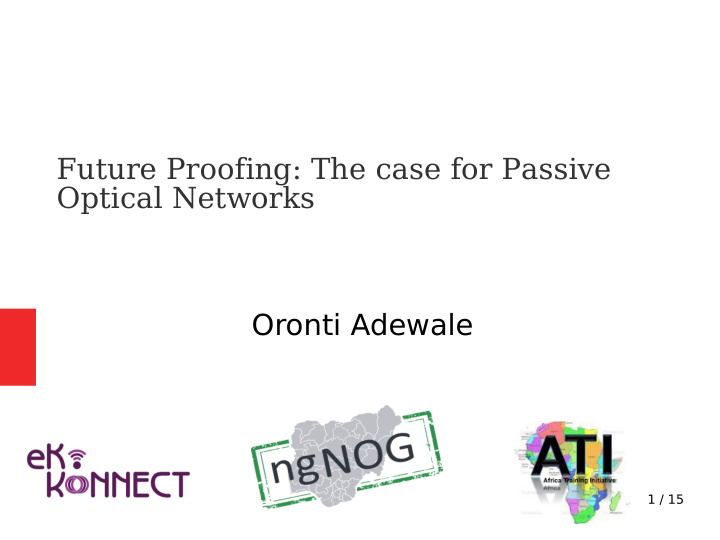



Future Proofing: The case for Passive Optical Networks Oronti Adewale 1 / 15
Pass ssive ive Opt Optica ical Net etwork ● Passive Optical Network (PON) is a system that brings optical fiber cabling to the end user. ● A telecommunication technology that implements a point-to-multipoint architecture, in which unpowered fiber optic splitters are used to enable a single optical fiber to serve multiple end-points. ● The system can be described as fiber-to-the-curb (FTTC), fiber-to-the-building (FTTB), or fiber-to- the-home (FTTH). 2 / 15
Topology Ove Topology Overview view https://help.ubnt.com/hc/en-us/articles/115009403308-UFiber-GPON-Getting-Started 3 / 15
Char arac acterist stics s an and A Advan antag ages o s of P PON The purpose of PON is to carry Ethernet packets across ● much further distances with less noise and greater bandwidth. Consider the GPON network as a high-bandwidth, long ● distance carrier for Ethernet Packets. PON allows for Triple Play such as providing Internet, ● Voice, & TV also known Triple Play. PON uses a Passive Optical Network with Single-Mode ● Fiber which allows long distances without the need for “active” distribution points. Mass deployment scenarios are capable for multi-dwelling ● units (MDUs) 4 / 15
Com Compon ponent ents s of of PON ON ● Optical Line Terminal (OLT) that converts the sources into light ● Passive splitters of single mode fiber that carry the signal ● Optical Network Terminal (ONT): converts light back to a standard Ethernet connection. 5 / 15
Com Compon ponent ents s of of PON ON 6 / 15
Optical Line Terminal Resides in the datacenter or core network. ● Connects to the core switch using traditional Ethernet ● pluggables. Consists of modular PON cards. ● Provides redundant switching, control, and power capability. ● Each PON port typically connects 32 ONTs. ● Utilizes 128 bit AES encryption for downstream (broadcast) ● traffic Utilizes Time-Division-Multiple-Access (TDMA) for upstream ● traffic. 7 / 15
Passive Optical Splitter Passive Optical Splitters connect to each PON port and ● replicate traffic downstream (to the end user’s ONT) while combining end user traffic in the upstream direction. Requires no power or cooling (hence the word “passive”) ● Can be placed anywhere in the midspan of the fiber network ● Typically deployed in above-ceiling fiber zone boxes near end ● user work areas The splitters and fiber components will last for decades ● 8 / 15
Optical Network Terminal The ONT serves as the end user interface to the network. ● Typically powered by a low voltage power brick. ● Converts the single mode fiber optical signal to RJ-45 Ethernet ● interfaces. Various models provide anywhere from 1 to 24 Ethernet Ports. ● Various models support Power-over-Ethernet (POE). ● Supports VLAN, 802.1x, and QoS. ● Can be deployed on the desktop, wall-mounted, or rack- ● mounted. 9 / 15
PON Use Cases Hotels ● Housing Estates ● Apartments and Domitories ● Triple Play Capabilities – Ethernet, Voice and Cable TV ● 10 / 15
PON PON D Depl ployment E Example https://help.ubnt.com/hc/en-us/articles/115009403308-UFiber-GPON-Getting-Started 11 / 15
Economic Advantages Passive Optical LAN provides substantial savings in CapEx ● and OpEx compared to legacy LAN designs Can eliminate wiring closets ● Eliminates the need for midspan electronics, power, and ● cooling infrastructure Uses smaller, lighter, less expensive cables to reduce pathway ● and space requirements Virtually eliminates the need to refresh cabling infrastructures ● As technology evolves, only the active endpoints need a ● refresh. 12 / 15
Li Limitat ations Passive, no full control of bandwidth allocation. Not truly symmetrical. GPON has slower upload speeds. ● Difficult to update and scale if your business needs more ● bandwidth in the future. No Quality of Service (QoS) or Class of Service (CoS), ● unable to prioritize critical data. Less secure when all subscribers’ data is sent over the ● same connection. Scattered connections make it difficult to pinpoint failures. ● Speeds can slow down during peak usage times. ● Can’t support speeds over 1Gb. ● 13 / 15
Summary Gigabit Passive Optical Network (GPON) is a cost-effective point-to-multipoint access network, which brings great improvement in data transmission distance (up to 20km) and bandwidth (an downstream capacity of 2.5Gbit/s and an upstream capacity of 1.25Gbit/s ). However, GPON’s higher bandwidth and split ratios are only achievable by using GPON- capable optical transceivers. It is well positioned to help meet the needs for higher bandwidth in FTTx applications, and continues to fuel growth in demand for GPON SFP modules. 14 / 15
Questions. 15 / 15
Recommend
More recommend